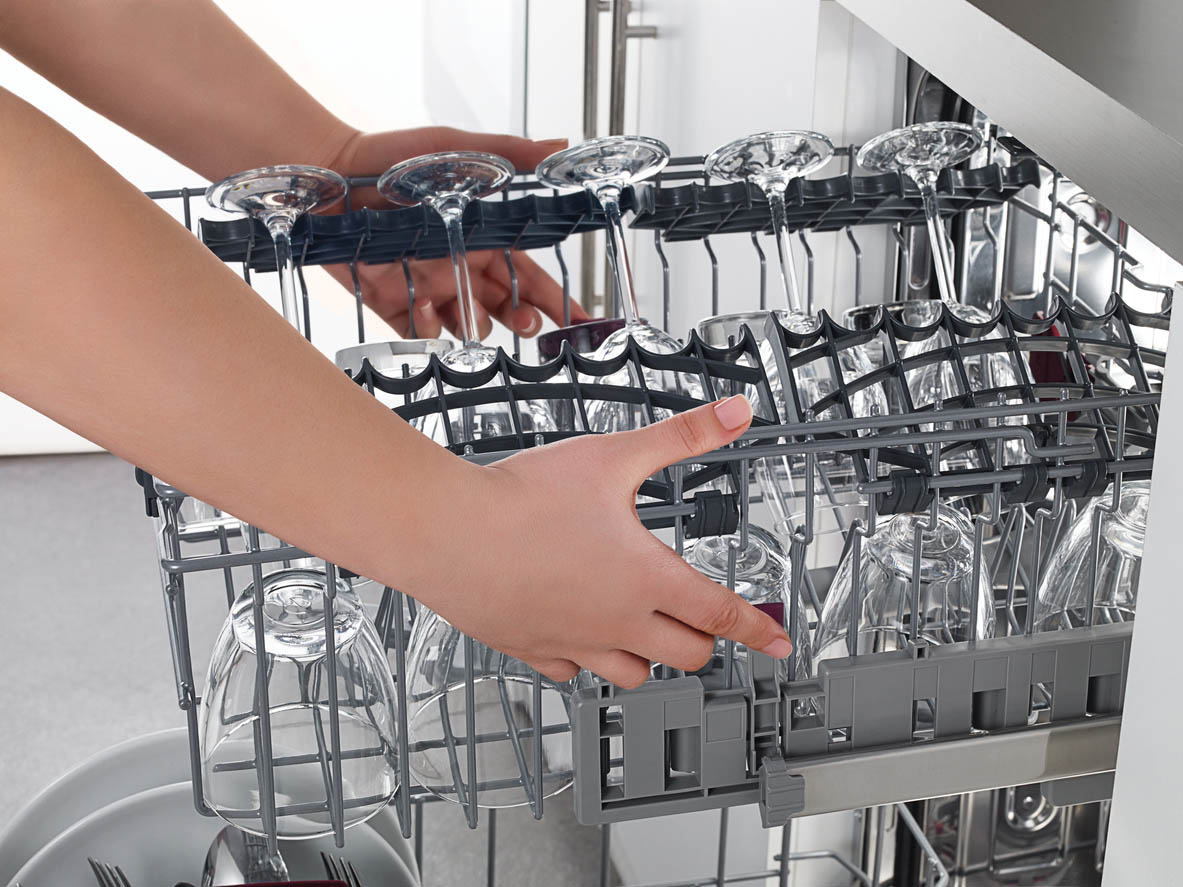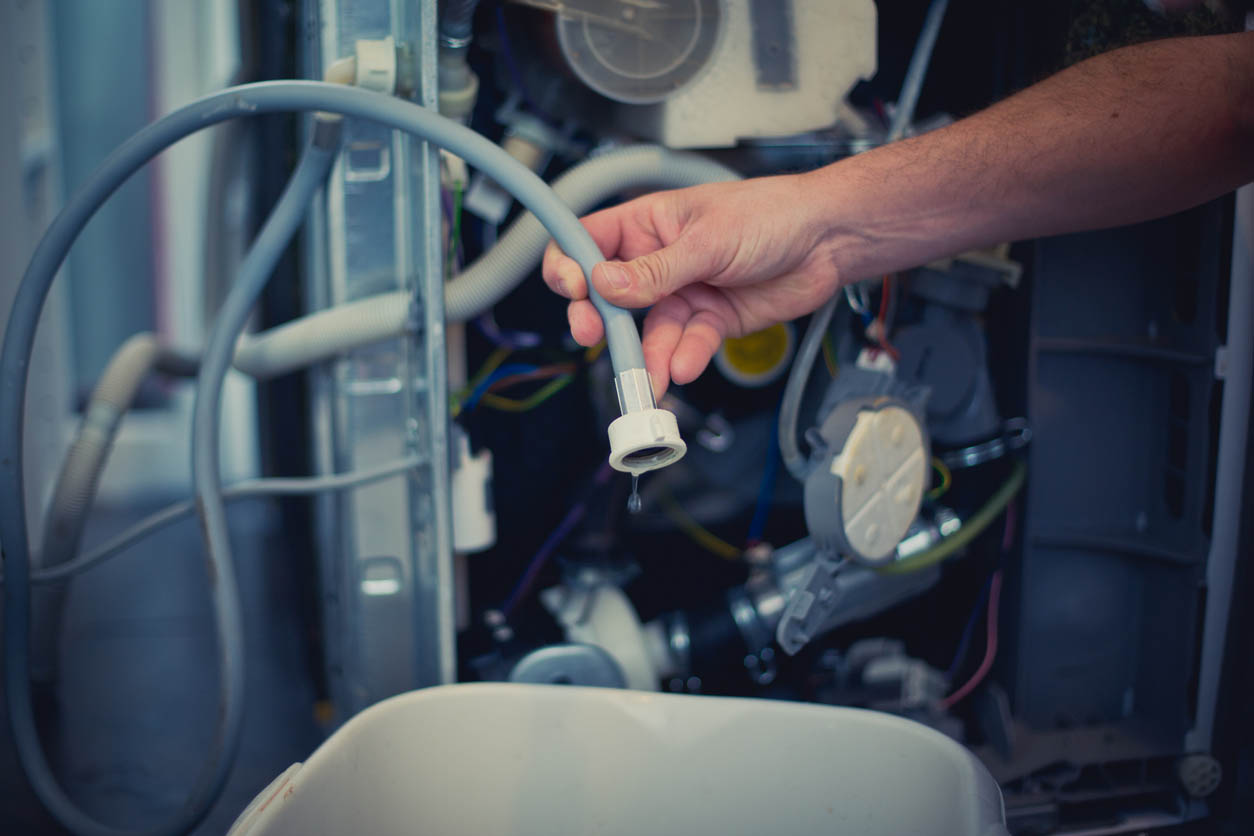We may earn revenue from the products available on this page and participate in affiliate programs. Learn More ›
The dishwasher is a kitchen workhorse: it cleans crud off the dishes and scrubs pots and pans. So it stands to reason that it should clean itself in the process, right? Unfortunately, that’s not the case. A series of filters stands between chunks of food and your plumbing, protecting the pipes from clogging. Unless the dishwasher has been sluggish for a while, the issue is likely within the unit. Luckily, these filters are designed to be cleaned by consumers, so there’s a good chance that with some effort, you’ll be able to avoid hiring a plumber. Of course, there are times when professional assistance may be necessary; it’s always possible that the trouble is farther down the line or there’s a failure of a control panel or pump. Alternatively, you may want to hire an appliance repair professional simply because you don’t want to risk making the problem worse or completely breaking your dishwasher. Thankfully, much of the time, clearing, cleaning, and rerunning the dishwasher will bring it back to the high performance you’re used to.
Time required: 1 hour plus cycle runtime
Difficulty: Beginner to intermediate
Estimated cost: Free
Tools & Materials
Bobvila.com may earn a commission from purchases made through these links.
- Dishwasher user’s manual
- Cushion or garden kneeler (optional)
- Towels or rags
- Bucket for wet towels
- Hand siphon pump
- Flashlight
Before You Begin…

It’s a good idea to make sure the dishwasher is actually clogged. While cleaning the filters and clearing the hose are never bad ideas, you can save yourself some trouble by rerunning the dishwasher before you start trying to find the clog. If someone accidentally opened the dishwasher during a cycle, it will appear that water has pooled in the bottom when the cycle is just unfinished. Rerunning the cycle will give the unit a chance to drain.
Because most of the cleaning magic happens behind the dishwasher’s closed door, it’s easy to forget that this is an appliance in which water and electricity come together. This calls for some extra attention to safety when working with the interior.
How to Unclog a Dishwasher: Tips
- Gather some towels or rags. There will be water pooled in the bottom of the washer and underneath the filters, and you’ll need to sop it up and wipe down interior surfaces.
- Find a cushion or garden kneeler to protect your knees. The filters may require some awkward positions to reach them.
- Grab a flashlight. If you need to shut off the dishwasher at the breaker, your kitchen lights may be on the same circuit. Even if your lights are on, a flashlight can help you see deeper inside the machine.
- Find the manual that came with your dishwasher. If you can’t locate it, the manufacturer’s website should have it available. Check the model number on the sticker, usually located on the washer’s front edge.
Safety Considerations
- Make sure the dishwasher is turned off and unplugged. If the dishwasher doesn’t have an accessible plug, turn it off at the breaker.
- Cleaning a dishwasher requires bending, leaning, and reaching into the interior of the machine. Figure out where you can safely lean, and remove the racks so you don’t catch your hair or clothes on the prongs.

STEP 1: Remove all the dishes and make sure the dishwasher is turned off and unplugged.
Remove any dishes from the machine. Stack them to the side or wash them by hand to get them out of the way. Turn off the dishwasher and unplug it, or turn off the circuit at the breaker. This is not a time to try to skate by without turning off the power; you will be putting your hand into standing water with an electrical element.
STEP 2: Remove all the stagnant water.
Remove the dish racks from the machine to gain access to the bottom pan. Soak up water with towels, or use a small hand siphon pump if you have one handy. If there’s too much water to soak up with towels, the pump is a helpful and inexpensive tool to pick up. Have a bucket nearby for the wet towels.
STEP 3: Remove and clean the hose drain and filter.
Once the water is out, examine the grate or mesh that covers the drain area. Use a flashlight if needed. Most dishwashers have a cylindrical filter that you can twist off and a flat filter in the bottom. If you spot chunks of food caught in the grate, you may have located the problem. Some filters have a small lever or handle to remove them, while others require a screwdriver to pop them out or unscrew them. Once removed, clean the grates and mesh thoroughly in the sink using warm, soapy water. Use a toothbrush or fork to remove any particles, then wipe out any debris in the area surrounding the filter and replace the filter.

STEP 4: Make sure the drain hose is not clogged.
The dishwasher drain hose connects the drain from the bottom of the dishwasher pan to the garbage disposal, so a clog could be the reason the dishwasher won’t drain. You may be able to access the hose where it connects to the garbage disposal, or you may need to remove the front panel of the dishwasher underneath the door. Some drain hoses are located behind the dishwasher, which is more complicated. Check the manual to find the access point. Use tongue-and-groove pliers to disconnect the drain hose from the disposal or the drain.
Check for a clog by simply blowing through the hose. If it’s clear, this isn’t the source of the issue. Use a coat hanger or drain clearing wire to remove any clogs, but don’t use a drain snake; the hose’s material isn’t strong enough to withstand the sharp edges of the snake. Reattach the hose to the disposal and the drain.
STEP 5: Check the plumbing connections.
The dishwasher has plumbing connections to the water supply, the drain hose, and the solenoid (the device that allows the water inlet hose to fill the dishwasher with water), supported by a hose clamp. If you’ve just cleared the drain hose, it should be firmly reattached at both ends. Check that the water supply hoses are tightly attached. Then examine the hose clamp and the solenoid. The clamp should be holding the solenoid in place without kinks or snags, and the water inlet hose should be free of debris or clogs.
STEP 6: Run the dishwasher again.
Once the hoses and filters are reinstalled, return the racks to their positions. If there is a lot of grease or gunk along the edges of the washer, run a vinegar cycle. Pour 3 cups of white vinegar into the dishwasher’s bottom, and run the dishwasher without dishes on the hottest cycle. The vinegar will degrease and remove detergent buildup from the interior. It will also remove any residual gunk from the hoses and the spray arm holes. If the cycle completes and drains properly, it’s time to reload the dishes and get the washer back to work!
If the problem continues, it’s time to call in some professional help—either a plumber or an appliance repair expert—to check for more extensive issues. Once the dishwasher is operating correctly, some preventive maintenance, choosing to opt for a home warranty plan, and your newfound familiarity with the filters can help prevent future problems. Scraping large particles from dishes before loading, regularly cleaning the filters, and occasionally running a vinegar cycle will prevent buildup and help you avoid clogs.


